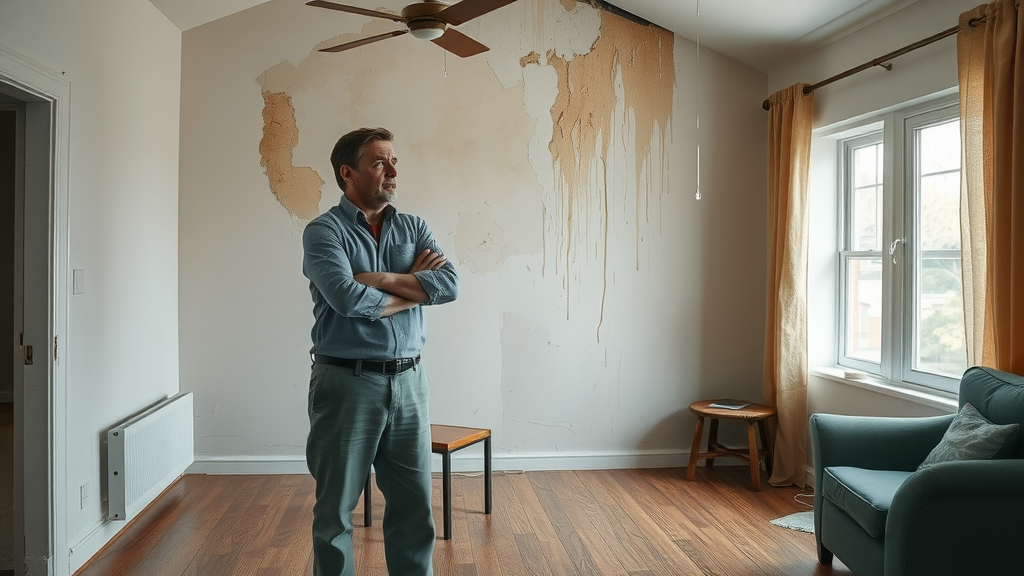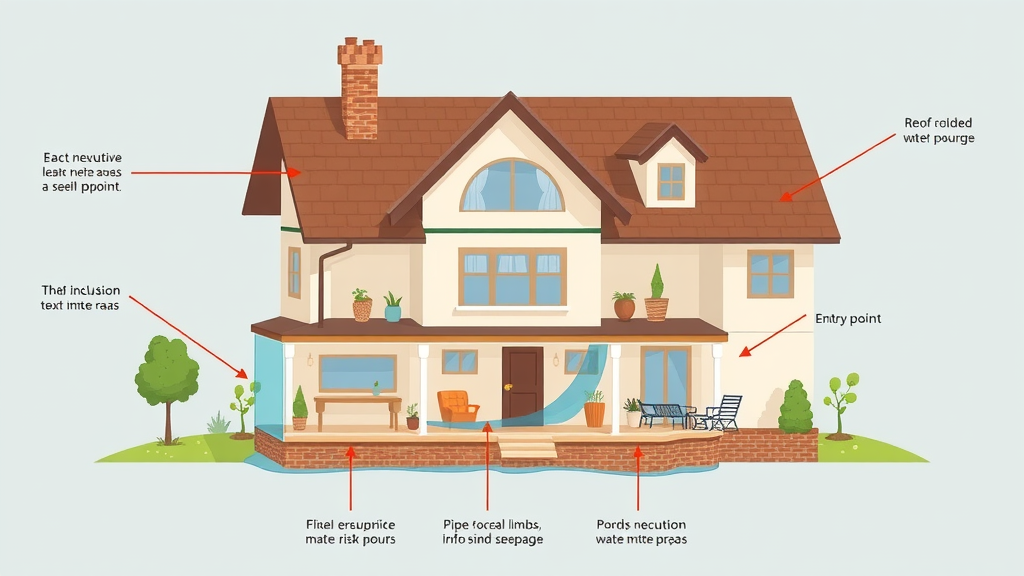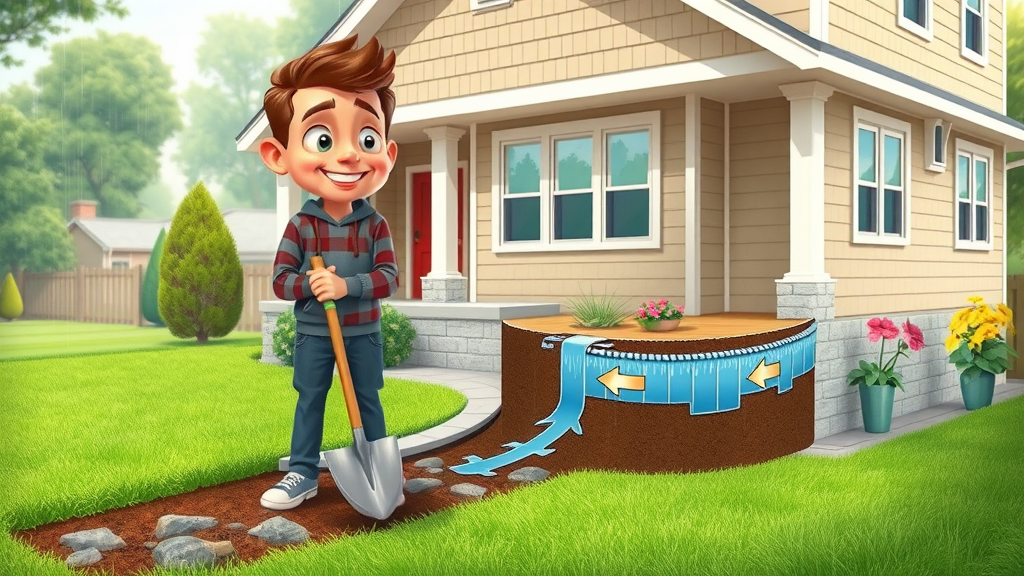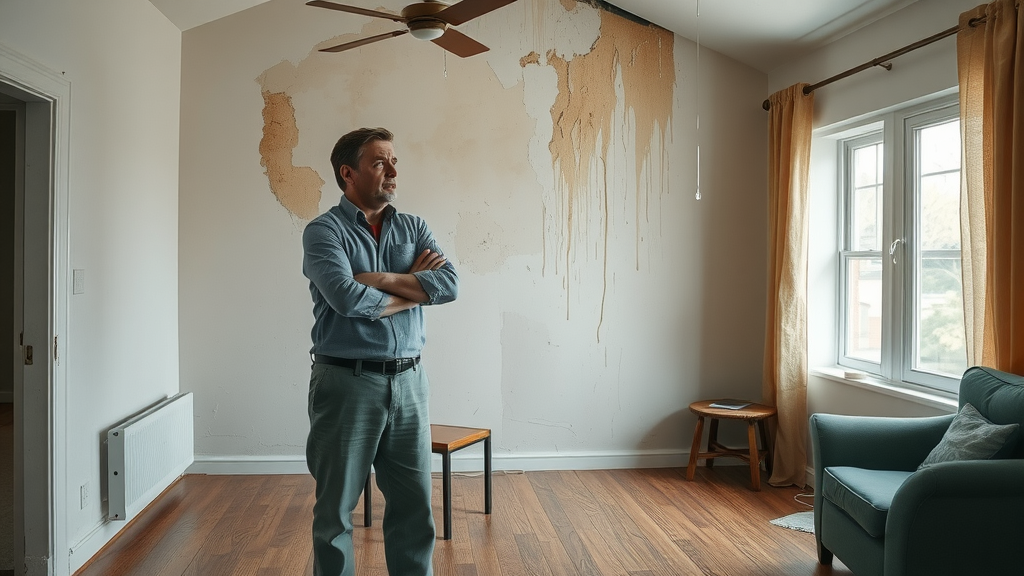Did you know? According to the Federal Emergency Management Agency, just one inch of water in your home could easily cause over $25,000 in damage. Most Lexington, SC homeowners don’t realize the true risks of water damage until it’s too late—often after a costly insurance claim and significant home repairs. This guide gives you the most effective water damage prevention tips to keep your home safe, secure, and dry no matter what challenges arise.
Shocking Water Damage Statistics Every Homeowner in Lexington SC Should Know
Water damage is a more common threat to Lexington, SC homes than most residents imagine. Statistics reveal that nearly one in fifty insured homes will experience a water loss or damage claim annually. In fact, next to wind and hail, water damage is the leading cause of property insurance claims in the U.S. for homeowners—a truly alarming reality when you consider the average claim runs into the thousands of dollars. The risk is even higher in regions like Lexington, where storms, high humidity, and aging infrastructure increase vulnerability.
This is not just about the big disasters, such as river floods. Everyday events like leaking pipes, malfunctioning sump pumps, and even roof seepage after a single powerful storm can lead to water intrusion, resulting in structural damage and costly repairs. The worst case scenario? Undetected leaks that persist for an extended period, resulting in mold infestations, irreparable harm to drywall and floors, and eligibility issues with insurance policies. Knowing these risks and addressing them with water damage prevention tips is essential for keeping your home safe, your insurance claim process smooth, and your repair bills manageable.

Why Water Damage Prevention Tips Are Crucial for Your Home Safety
The need for reliable water damage prevention tips is not just about peace of mind—it’s about safeguarding your long-term investment. Water intrusion threatens damage to your home at a structural level, impacts living conditions, and can create uninsurable risks if not addressed quickly. Even the most minor water leak or unnoticed moisture can compromise your home’s safety, leading to problems like electrical shorts, weakened foundations, or the hidden growth of dangerous black mold.
Implementing water mitigation strategies, like regular roof inspection or installing a main water shut off valve, is critical to minimizing loss and preventing catastrophic events. Insurance claim issues often arise if the homeowner is found negligent, such as ignoring leaks for an extended period or failing to maintain sump pumps or water leak detectors. By taking an active approach, you avoid the difficult scenario of fighting denied insurance claims and reduce potential health and financial risks. Adopting these prevention tips today is an investment in your family’s safety and the protection of your most valuable asset—your home.
What You’ll Learn: Essential Water Damage Prevention Tips for Lexington Residents
- How to prevent water damage in your home
- Signs of water leak and water loss
- Immediate water mitigation steps
- When to file an insurance claim
- Keeping your home safe and sound
Understanding Water Damage: Causes, Risks, and Long-Term Impact
True water damage is rarely obvious in the beginning. Many Lexington, SC homeowners discover the real costs of water intrusion only after an extended period of undetected leaks or poor maintenance. Issues can start with a minor water leak under a sink, an old sump pump failing during a downpour, or poor drainage near the home’s foundation. Without attention, such problems often escalate into significant damage to your home—including structural damage, ruined flooring or drywall, compromised wiring, and the hidden growth of toxic mold.
The risks are not limited to your immediate comfort. Permanent water infiltration can lead to higher insurance premiums, value loss, and even the denial of future insurance policies or claims. For Lexington residents, water damage often equals insurance claim challenges, mold remediation bills, and the pain of “what could have been prevented.” Knowing the causes, acting quickly, and keeping an eye on your home’s systems are non-negotiable parts of responsible homeownership.

Common Causes of Water Damage
Several everyday factors contribute to unwanted water intrusion in Lexington, SC homes. Roofs that are missing shingles or have been poorly maintained represent a major pathway for rainwater to enter and cause hidden damage for an extended period. Similarly, clogged or sagging gutters can force rainfall to pool along the foundation, setting the stage for costly repairs. Another frequent cause includes leaking pipes or failed plumbing joints, with water loss often going unnoticed until the signs are unmistakable—swollen floors, peeling paint, or unexplained musty odors.
Appliances are also culprits for water damage. Water heaters, dishwashers, washing machines, and even HVAC units can develop slow leaks, leading to puddling or hidden dampness behind walls. Even newer homes are at risk if sump pumps are not properly maintained, leak detectors are absent, or poorly graded landscaping directs water toward the house instead of away from it. Knowing these vulnerabilities helps you proactively protect your home and prepares you to respond quickly, minimizing the risk of denied insurance claims and costly water damage repair.
The Extended Period: Hidden Risks of Delaying Water Mitigation
Failing to address water issues quickly—even minor leaks or noticeable drips—can have serious long-term consequences. Water left to soak into drywall, wooden studs, or subflooring for an extended period promotes the growth of hazardous mold spores and weakens your home’s structure. Moisture that lingers increases the risk for rot, electrical faults, and even irreversible damage to insulation and finished surfaces. The longer you wait, the harder it becomes for your homeowners insurance policy to cover the resulting damage claim.
In Lexington, insurance claim adjusters frequently note in their investigations whether immediate water mitigation steps were taken. If not, homeowners may be denied coverage for “negligence”—leaving you to pay for expensive repairs out-of-pocket. Fast action is essential to prevent your home safe from escalating issues—turning off the main water valve, promptly fixing the source, and beginning the drying process within the first 24 hours whenever possible. Proactivity not only protects your home but supports a successful outcome should a claim become necessary.
The True Cost of Water Loss and Insurance Claims
Hidden water loss can be devastating—both financially and emotionally. It’s easy to underestimate how much a single incident can cost. Water loss doesn’t just require replacing ruined carpeting or patches of drywall; the full cost may include structural repairs, furniture replacement, professional remediation for mold, and even hotel expenses if your home becomes temporarily uninhabitable. The pain is compounded if you’re forced to file an insurance claim that gets denied due to lack of documentation or delayed response.
Insurance claim processes are complex, with policies often containing strict language around prompt reporting and maintenance responsibilities. Homeowners in Lexington, SC must read their policies carefully, documenting every step taken to mitigate water damage. By following proven water mitigation steps and maintaining accurate records, you increase the likelihood your damage claim will be honored and reduce your personal liability for related loss.
“A single inch of floodwater can cost you upwards of $25,000 in damage to your home – don’t wait until it’s too late.”
10 Proven Water Damage Prevention Tips to Keep Your Home Safe
Prevention is always the best defense. By acting before water strikes, Lexington residents can dramatically reduce the likelihood of a costly water damage claim and keep their homes dry and comfortable. Here are the top 10 water damage prevention tips every homeowner should implement to safeguard against water loss, panic-filled insurance claims, and extensive repairs.
- Inspect Your Roof and Gutters Regularly: Check for missing or cracked shingles, and clear out leaves and debris.
- Check for Plumbing Leaks and Water Loss: Keep an eye on pipe joints, faucets, and appliance hookups for signs of moisture.
- Install a Sump Pump and Maintain It: Ensure your sump pump is working before storms hit, testing it at least twice a year.
- Seal Windows and Doors Properly: Use weatherproof caulking to stop rainwater from seeping in.
- Grade the Landscape Away from the Foundation: Ensure the soil slopes away from your home to avoid basement leaks.
- Test Your Water Leak Detectors: Place sensors in high-risk areas, like basements, kitchens, or near water heaters.
- Clean and Maintain HVAC Units: Regularly check for blockages, leaks, or condensation issues.
- Know Your Main Water Shut-Off Valve Location: In an emergency, shutting off the water main stops further water loss immediately.
- Invest in Water-Resistant Building Materials: Consider tile, concrete board, or sealed flooring in lower-level rooms.
- Keep an Emergency Water Mitigation Kit: Stock up on tarps, towels, a wet/dry vac, and portable fans for speedy response.

Water Mitigation Strategies: Acting Fast to Prevent Water Damage
Even with the best intentions and consistent maintenance, water emergencies can still occur. The key to limiting damage to your home—and ensuring the success of an insurance claim—lies in rapid water mitigation. This means understanding the steps to take as soon as water is discovered, and knowing when to escalate to professionals for water mitigation or repair. The sooner you address the problem, the more likely you are to prevent secondary issues like mold and foundation damage.
Always keep critical supplies at hand, know your main water valve location, and ensure your sump pump is operational, especially during storm season. The first moments after discovering water intrusion matter most, not merely for minimizing the visible mess but for safeguarding walls, insulation, and your family’s well-being. Create a plan and rehearse it with your family—quick coordination limits the loss and increases your peace of mind.
What To Do Immediately After Discovering Water Damage
The priority when water is discovered is to shut off the water main if possible and move valuables to a dry area. Next, use a wet-dry vacuum and towels to soak up standing water, and set up fans or dehumidifiers to reduce the moisture level. Contact a professional for water mitigation if the area affected is large, if you suspect mold, or if sewage is involved. Document the damage carefully (take clear, time-stamped photos) and keep all receipts from supplies used—you’ll need this evidence should you file a damage claim with your insurance policies.
Don’t attempt repairs that involve your electrical system or significant reconstruction unless you’re trained to do so. Mold can develop rapidly, within 24–48 hours after water exposure. Follow up with your insurance provider to see if immediate restoration services are covered. By acting quickly and systematically, you keep your home safe, improve your claim chances, and limit both the financial and health-related loss from water damage.
When and How To File an Insurance Claim for Water Damage
Should your efforts at water mitigation fall short or if the loss is extensive, it’s critical to file an insurance claim as soon as possible. Begin by reviewing your homeowners insurance policy to ensure your specific type of water damage is covered—certain policies exclude damages caused by gradual leaks or lack of maintenance. Contact your provider immediately with detailed information about the incident, including the time, cause, and steps you took for immediate mitigation.
Documenting the process is essential: keep clear records of all communications with your insurer and service professionals. Take photographs and videos of all visible damage, including appliances like water heaters or sump pumps involved in the problem. Provide your insurance adjuster with every receipt and service invoice, and don’t discard damaged items before approval. Acting swiftly not only limits water loss but helps you move through the claim process efficiently, resulting in a higher chance of having your damage claim paid out quickly.
Swift action not only limits water loss but may also speed up the insurance claim process.” – Palmetto Mold Experts
| Prevention Measure | Estimated Cost | Effectiveness | Maintenance Frequency |
|---|---|---|---|
| Roof Inspection | $150-$400 | High | Yearly |
| Sump Pump | $700-$1500 | High | Twice a Year |
| Leak Detectors | $50-$150 | Moderate | Biannually |
Expert Answers: People Also Ask About Water Damage Prevention Tips
How can I prevent water damage?
- Regular inspections
- Quick repairs
- Proactive water mitigation
- Proper grading
- Sump pump maintenance
Preventing water damage starts with consistency. Schedule regular checks of your roof, gutters, plumbing, and appliances to spot leaks early. Tackle repairs immediately—delays often lead to larger structural damage and denied claims when you eventually file for insurance. Water mitigation is more than clean-up after the fact; invest in water leak detectors, slope your lawn away from your house, and always keep your main water shut off valve accessible. Maintaining your sump pump and HVAC reduces surprise failures—the few dollars spent now could prevent thousands in water damage repair down the road.

What to spray to prevent mold after water damage?
- EPA-registered mold inhibitors
- Bleach solution (for non-porous surfaces)
- Professional-grade fungicidal sprays
Mold prevention is essential after water mitigation. For best results, act quickly—mold can begin developing within 24–48 hours. Use an EPA-registered mold inhibitor spray on all at-risk surfaces, particularly drywall, wood, and flooring. For small, non-porous areas, a 1:10 dilution of household bleach is effective. For more severe cases or to protect your home safe, consider hiring professionals who use commercial-grade fungicidal sprays that eliminate spores and provide a protective barrier. Always ventilate your home thoroughly during treatment, and consider running a dehumidifier to keep moisture levels low.
How do I keep water from damaging the foundation of my house?
- Ensure proper drainage away from home
- Install and maintain gutters
- Repair cracks and seal foundation
- Use landscaping to direct water
Keeping your foundation protected is a core part of all water damage prevention tips. The first line of defense is properly graded landscaping—your yard should slope away from your foundation to divert rainwater and melted snow. Clean and maintain gutters and downspouts so water is carried safely away from your home. Inspect and seal cracks in your foundation walls annually to block seepage. You can also plant flower beds or install a French drain system as a way to further redirect water away from the house, making this one of the best ways to prevent costly flood damage and keep your family’s sanctuary strong for years to come.

How long until water damage causes mold?
- Mold begins to grow within 24–48 hours after water intrusion
Speed is key when water damage occurs—mold spores are everywhere and only need a damp environment to flourish. In most cases, visible mold forms within 24 to 48 hours after a water leak or flood. That’s why immediate water mitigation (removing standing water, drying soaked materials, and lowering humidity) is so critical. If your home has experienced water loss, monitor for musty odors or discolored spots on walls and ceilings, and call in professionals at the first sign. Addressing the issue early keeps your home safe and healthy—and helps ensure your insurance claim remains valid.
Key Takeaways: Keep Your Home Safe with Water Damage Prevention Tips
- Prevent water damage with regular maintenance and fast response
- Act quickly: water mitigation is time sensitive
- Use a combination of monitoring, home improvement, and professional help
Frequently Asked Questions: Water Damage Prevention Tips
- How can water mitigation help prevent costly repairs?
- Are water leak detectors really worth the investment?
- What is the difference between water loss and water damage?
- Will my insurance claim be affected if I act slowly?
Conclusion: Protect Your Home with Actionable Water Damage Prevention Tips
Act Today with These Water Damage Prevention Tips for Lexington, SC
- Inspect your home, respond quickly to leaks, and embrace regular maintenance to keep your home safe.
- Don’t wait—take steps today to prevent water loss, structural damage, and insurance complications tomorrow.

Need Help With Water Damage? Contact Water Damage Repair in Lexington SC
Water Damage Repair In Lexington SC –https://palmettomoldexperts.com/lexington-sc-mold-removal/
Watch: Fast Water Damage Prevention Tips in Video
See real-life demonstrations of the best water mitigation techniques, from stopping leaks to using your main water shut-off valve. Emergency scenarios in Lexington SC homes show step-by-step solutions you can apply right now.
Watch: Sump Pump Maintenance and Water Mitigation Best Practices
Follow along for maintenance routines that keep your sump pump reliable—plus expert tips for water mitigation and leak prevention in every Lexington home.
Sources
- https://www.fema.gov/citizen-responders/water-damage-repairs – FEMA: Water Damage and Repairs
- https://www.iii.org/fact-statistic/facts-statistics-water-damage – Insurance Information Institute: Facts + Statistics: Water Damage
- https://www.epa.gov/mold/mold-cleanup-your-home – EPA: Mold Cleanup in Your Home
- https://palmettomoldexperts.com/lexington-sc-mold-removal/ – Palmetto Mold Experts: Lexington, SC Mold Removal
To further enhance your understanding of water damage prevention, consider exploring the following resources:
-
“11 Proven Tips to Safeguard Your Home Against Water Damage” (unicainsurance.com)
-
“5 Tips to Help Prevent Water Damage in Your Home” (homefirstagency.com)
These articles provide comprehensive strategies and practical advice to help you protect your home from potential water damage.

